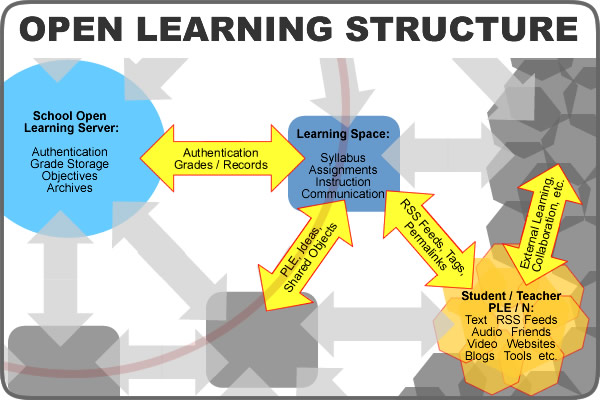So as I have been looking at what, for lack of better words, would be the “basics” of open learning. I have been adding different layers and ideas to the original ones examined in part 1. In part 2, I added how the various Learning Spaces would interact with each other. This post will look a bit at how the student Personal Learning Networks would interact with the overall idea.
Due to recent announcements from Blackboard, I have been waiting a bit to see how their new directions will fit into the Open Learning world. I attended a sneak preview of their next generation product, and to be honest… I am not sure. It seems like they are recreating Facebook as a learning-centered social network in some ways. But there are ways to connect to external services like Facebook and Twitter. So a lot of that remains to be seen – but that can be figured out later. For now, on to the new and improved open learning diagram:
Personal Learning Environments / Networks
If you are online, you probably already have a PLE or PLN. Possibly even both. The network would be the people you follow, read, etc regardless of platform – as well as the people that read and follow you. The environment would be the tool or tools you use to bring in everything you want to read – like Google Reader, a list of certain topical pages on Facebook, or something else like that. If you use them, then you would use several environments to create your network. The main idea is that no two people create the same PLE/N, but they all interact with each other.
We all know that we can control our identity in our own PLE/N. We can post anonymously in some places, as ourselves in others, and as a fictitious pseudo-name in others. I have already touched on how this is important for privacy issues. I just want to touch base with the idea again to re-enforce the point that many others (Siemens, Downes, Groom, Cormier, etc) have made: open learning gives students more control over their identity and therefore fulfills the original intent of FERPA and other privacy measures.
The downside to realize is that students will need much, much, more education on what that control means.
So, back to the diagram. I made another change in that the Student PLE looks more like a cloud of environments, rather than just one static shape. This is more in line with how a PLE/N really works. So many things over lap out there on the web. Many students work together. Many students go off on a side tangent and discuss or investigate things that are external to the course topic. All of this is a valid part of the learning process. It is impossible to draw hard, fast lines in this cloud – I really just put an arrow there to highlight what could happen, but it is really not that neat and tidy.
Another important facet to point out is that the arrow between a specific student’s PLE/N and the Learning Space goes both ways, as students can also learn from the instructor as well as submit new ideas and concepts to be learned by the instructor. In reality, the Learning Space would not necessarily be where you would place the instructor on this diagram. They would be one of many nodes existing out in the “cloud” of PLE/Ns. This is why the diagram says “Student / Teacher PLE / N” – the instructors would be the administrators of the Learning Space and the guides of what students learn, but ultimately they would be in the network sharing and learning along with the students.
The bigger picture would look like a huge cloud of PLE/Ns. As you get closer to the school itself, this cloud would form more order and organization, as students and teachers make sense of what they are learning. The Learning Spaces would form the technology barrier between the chaotic learning cloud and the learning institutions. These spaces would be where learning is observed, where ideas are organized into assignments, where interaction is organized into discussions. This organized content would be sent to the university or other institution for analysis, proof of learning, statistics etc. But this organization would also be spit back out into the cloud of learning for others to learn from, tear through, re-organize, re-mix, etc.
The idea is to have a constantly moving, changing, chaotic, living, growing, breathing process of learning rather than the static, predictable unidirectional process that we currently have.
Matt is currently an Instructional Designer II at Orbis Education and a Part-Time Instructor at the University of Texas Rio Grande Valley. Previously he worked as a Learning Innovation Researcher with the UT Arlington LINK Research Lab. His work focuses on learning theory, Heutagogy, and learner agency. Matt holds a Ph.D. in Learning Technologies from the University of North Texas, a Master of Education in Educational Technology from UT Brownsville, and a Bachelors of Science in Education from Baylor University. His research interests include instructional design, learning pathways, sociocultural theory, heutagogy, virtual reality, and open networked learning. He has a background in instructional design and teaching at both the secondary and university levels and has been an active blogger and conference presenter. He also enjoys networking and collaborative efforts involving faculty, students, administration, and anyone involved in the education process.
